Alkaline Silicate Metasomatism Recorded through Fe-Ti-Rich Mantle Xenoliths from the Calatrava Volcanic Field (Spain)
Abstract
1. Introduction
2. Geological Setting
3. Methods
4. Results
4.1. Petrography of Mantle Xenoliths
4.2. Whole-Rock Composition
4.2.1. Major and Trace Elements
4.2.2. Sr–Nd Isotopes
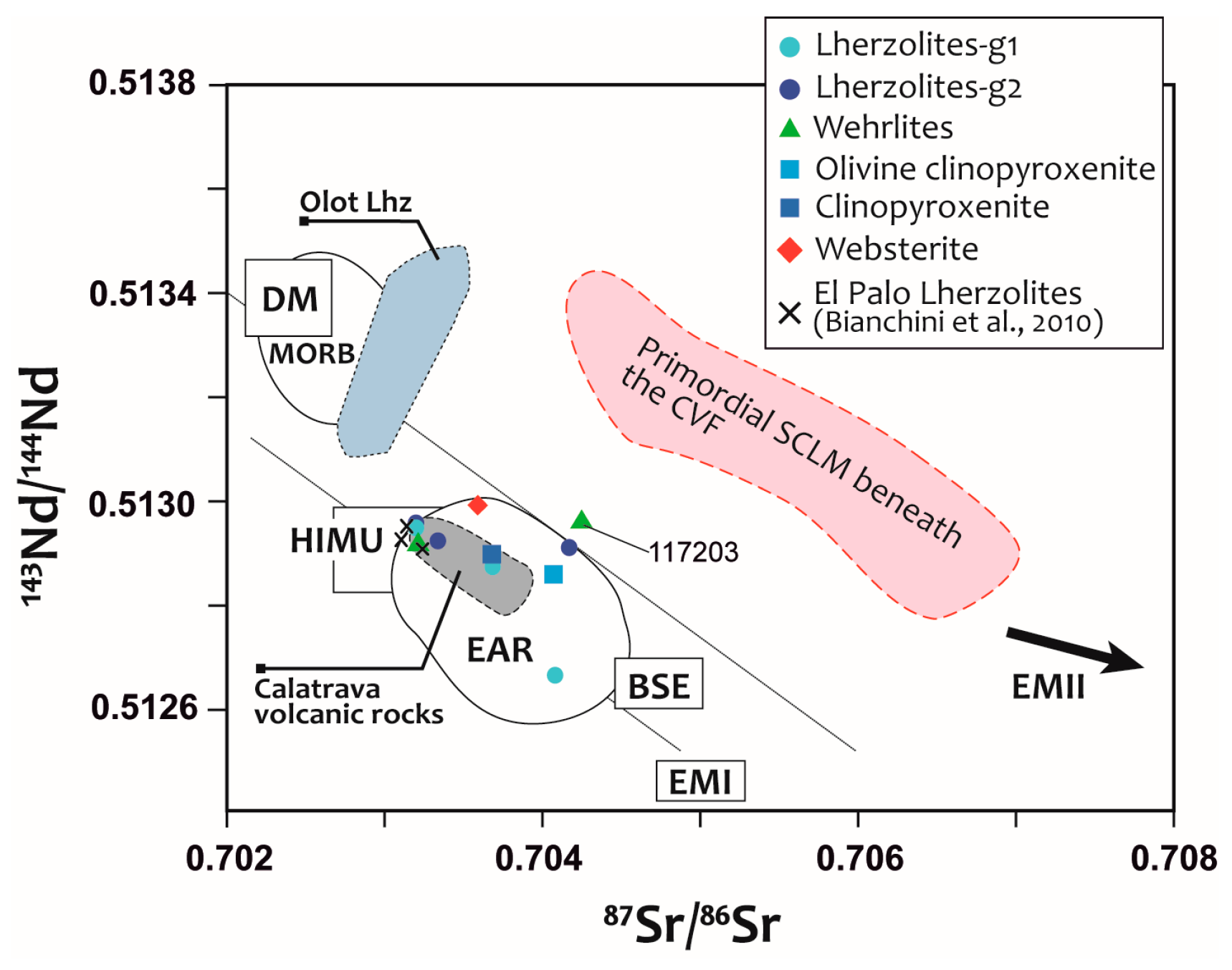
4.3. Mineral Chemistry
4.3.1. Major-Element Mineral Composition
4.3.2. Trace-Element Mineral Composition
5. Discussion
5.1. Nature of the Mantle Sources
5.2. Nature of Metasomatic Events in Peridotite Xenoliths
5.2.1. Origin of Cryptically Metasomatized Lherzolites and Fe-Ti-Rich Wehrlites
5.2.2. Origin of Pyroxenite Xenoliths
5.3. Origin of the Interstitial Glass
5.4. Calatrava Subcontinental Lithospheric Mantle
6. Conclusions
- (1)
- Four groups of ultramafic xenoliths have been distinguished in the Cerro Pelado and El Palo volcanic centers according to petrographic and compositional features: lherzolites, wehrlites-dunites, clinopyroxenites, and websterites. All of them show evidence of alkaline metasomatism, although in a variable degree. Lherzolites represent the less-refertilized mantle composition, whereas the other xenoliths would define trends of a more intensive transformation by silicate alkaline melts.
- (2)
- In situ partial melting during volcanic transport of the xenolith is considered the origin of the interstitial glass in the here-studied CVF peridotites. In the case of those anhydrous xenoliths (showing cryptic metasomatism, mainly in its clinopyroxene), partial melting would have been favored by their lower solidus temperature than for lherzolites and triggered by the thermal input and adiabatic decompression during their travel to the surface within the volcanic magma.
- (3)
- Most of the studied xenolith samples define a common trend of Fe-Ti-Ca enrichment in comparison with other CVF xenolith suites, although pyroxenites are depleted in Fe compared to associated lherzolites and wehrlites. Trace-element patterns are roughly similar, suggesting different conditions and refertilization degrees by alkaline silicate melts. In wehrlites, dunites, and clinopyroxenites, this refertilization has almost completely consumed all the primary orthopyroxene.
- (4)
- The singular El Palo websterite xenolith might represent a variety of alkaline metasomatism formed in a broad reaction zone with high melt–peridotite interaction rates occurring at higher pressure conditions than associated wehrlites or clinopyroxenites. This is markedly dissimilar to websterite enclaves (granulites) from the Spanish Central System, which have been interpreted as magmatic cumulates.
- (5)
- The here-studied Cerro Pelado and El Palo ultramafic xenoliths have an alkaline imprint, the most common refertilization in alkaline intraplate European Cenozoic volcanic fields. Alkaline magmatism in Iberia might be linked to extension processes from the Mesozoic to the Cenozoic periods. The great similitude with the Sr–Nd isotopic EAR-HIMU composition, along with metasomatic clinopyroxene (and amphibole) trace-element patterns being similar to those from megacryst-phenocrysts of Calatrava volcanics, highlights the main role of this last alkaline magmatism in metasomatic processes beneath Central Iberia. This alkaline-refertilized mantle adds to two other SCLM types described in Calatrava. The oldest one would correspond to a mantle domain close to a depleted-mantle (DMM) composition, whereas the second mantle type records metasomatic subduction imprints, which are probably linked to the Variscan collision.
Supplementary Materials
Author Contributions
Funding
Data Availability Statement
Acknowledgments
Conflicts of Interest
References
- Downes, H. Formation and modification of the shallow sub-continental lithospheric mantle: A review of geochemical evidence from ultramafic xenoliths suites and tectonically emplaced ultramafic massifs of western and Central Europe. J. Petrol. 2001, 42, 233–250. [Google Scholar] [CrossRef]
- Bianchini, G.; Beccaluva, L.; Bonadiman, C.; Nowell, G.M.; Pearson, D.G.; Siena, F.; Wilson, M. Mantle metasomatism by melts of HIMU piclogite components: New insights from Fe-lherzolite xenoliths (Calatrava Volcanic District, Central Spain). In Petrological Evolution of the European Lithospheric Mantle; Coltorti, M., Downes, H., Grégoire, M., O’Reilly, S.Y., Eds.; Special Publications 337; Geological Society: London, UK, 2010; pp. 107–124. [Google Scholar]
- Villaseca, C.; Ancochea, E.; Orejana, D.; Jeffries, T.E. Composition and evolution of lithospheric mantle in Central Spain: Inferences from peridotite xenoliths from the Cenozoic Calatrava volcanic field. In Petrological Evolution of the European Lithospheric Mantle; Coltorti, M., Downes, H., Grégoire, M., O’Reilly, S.Y., Eds.; Special Publications 337; Geological Society: London, UK, 2010; pp. 125–151. [Google Scholar]
- González-Jimenez, J.M.; Villaseca, C.; Griffin, W.L.; O’Reilly, S.Y.; Belousova, E.; Ancochea, E. Significance of ancient sulphide PGE and Re-Os signatures in the mantle beneath Calatrava, Central Spain. Contrib. Mineral. Petrol. 2014, 168, 1047. [Google Scholar] [CrossRef]
- Lierenfeld, M.B.; Mattsson, H.B. Geochemistry and eruptive behaviour of the Finca la Nava maar volcano (Campo de Calatrava, south-central Spain). Int. J. Earth Sci. 2015, 104, 1795–1817. [Google Scholar] [CrossRef]
- Puelles, P.; Ábalos, B.; Gil Ibarguchi, J.I.; Sarrionandia, F.; Carracedo, M.; Fernández-Armas, S. Petrofabric and seismic properties of lithospheric mantle xenoliths from the Calatrava volcanic field (Central Spain). Tectonophysics 2016, 683, 200–215. [Google Scholar] [CrossRef]
- Villaseca, C.; Belousova, E.; Barfod, D.; González-Jiménez, J.M. Dating metasomatic events in the lithospheric mantle beneath the Calatrava volcanic field (Central Spain). Lithosphere 2019, 11, 192–208. [Google Scholar] [CrossRef]
- García Serrano, J. Petrología y Geoquímica de los Xenolitos del Manto en los Volcanes del Campo de Calatrava (Ciudad Real, España). Ph.D. Thesis, Complutense University, Madrid, Spain, 2023; 299p. [Google Scholar]
- García Serrano, J.; Villaseca, C.; Pérez-Soba, C. Depleted lherzolite xenoliths from the leucititic Morrón de Villamayor volcano (Calatrava volcanic field, Spain). Lithos 2021, 380–381, 105830. [Google Scholar] [CrossRef]
- Villaseca, C.; García Serrano, J.; Pérez-Soba, C. Subduction-related metasomatism in the lithospheric mantle beneath the Calatrava volcanic field (central Spain): Constraints from lherzolite xenoliths of the Cerro Gordo volcano. Int. Geol. Rev. 2022, 64, 469–488. [Google Scholar] [CrossRef]
- García Serrano, J.; Villaseca, C.; Pérez-Soba, C. Xenolitos peridotíticos y piroxeníticos del volcán El Palo (Campo Volcánico de Calatrava, España). Geotemas 2021, 18, 422–425. [Google Scholar]
- Ionov, D.A.; Chanefo, I.; Bodinier, J.L. Origin of Fe-rich lherzolites and wehrlites from Tok, SE Siberia by reactive melt percolation in refractory mantle peridotites. Contrib. Mineral. Petrol. 2005, 150, 335–353. [Google Scholar] [CrossRef]
- Ackerman, L.; Jelínek, E.; Medaris Jr, G.; Ježek, J.; Siebel, W.; Strnad, L. Geochemistry of Fe-rich peridotites and associated pyroxenites from Horní Bory, Bohemian Massif: Insights into subduction-related melt–rock reactions. Chem. Geol. 2009, 259, 152–167. [Google Scholar] [CrossRef]
- Ancochea, E. Evolución Espacial y Temporal del Volcanismo Reciente de España Central. Ph.D. Thesis, Complutense University, Madrid, Spain, 1982; 675p. [Google Scholar]
- Cebriá, J.M.; Martín-Escorza, C.; López-Ruiz, J.; Morán-Zenteno, D.J.; Martiny, B.M. Numerical recognition of alignments in monogenetic volcanic areas: Examples from the Michoacán- Guanajuato Volcanic Field in Mexico and Calatrava in Spain. J. Volcanol. Geotherm. Res. 2011, 201, 73–82. [Google Scholar] [CrossRef]
- Ancochea, E. Rasgos generales del vulcanismo Neógeno peninsular. In Geología de España; Vera, J.A., Ed.; SGE-IGME: Madrid, Spain, 2004; pp. 671–672. [Google Scholar]
- Lustrino, M.; Wilson, M. The circum-Mediterranean anorogenic Cenozoic igneous province. Earth Sci. Rev. 2007, 81, 1–65. [Google Scholar] [CrossRef]
- De Vicente, G.; Vegas, R. Large-scale distributed deformation controlled topography along the western Africa-Eurasia limit: Tectonic constraints. Tectonophysics 2009, 474, 124–143. [Google Scholar] [CrossRef]
- López-Ruiz, J.L.; Cebriá, J.M.; Doblas, M. Cenozoic volcanism in the Iberian Peninsula. In The Geology of Spain; Gibbons, W., Moreno, T., Eds.; The Geological Society: London, UK, 2002; pp. 417–438. [Google Scholar]
- López Ruiz, J.; Cebriá, J.M.; Doblas, M.; Oyarzun, M.; Hoyos, M.; Martín, C. The late Cenozoic alkaline volcanism of the Central Iberian Peninsula (Calatrava Volcanic Province, Spain): Intra-plate volcanism related to extensional tectonics. J. Geol. Soc. Lond. 1993, 150, 915–922. [Google Scholar] [CrossRef]
- Ancochea, E.; Huertas, M.J. Radiometric ages and time-space distribution of volcanism in the Campo de Calatrava Volcanic Field (Iberian Peninsula). J. Iber. Geol. 2021, 47, 209–223. [Google Scholar] [CrossRef]
- Carminati, E.; Lustrino, M.; Doglioni, C. Geodynamic evolution of the central and western Mediterranean: Tectonics vs. igneous petrology constraints. Tectonophysics 2012, 579, 173–192. [Google Scholar] [CrossRef]
- Granja Bruña, J.L.; Vegas, R.; Sentre, M.A.; Muñoz-Martín, A.; Sainz-Maza, S. Gravity modeling of the lithosphere in the Calatrava Volcanic Province (Spain): Geodynamic implications. J. Iber. Geol. 2015, 41, 233–252. [Google Scholar] [CrossRef]
- Paton, C.; Hellstrom, J.; Paul, B.; Woodhead, J.; Hergt, J. Iolite: Freeware for the visualisation and processing of mass spectrometric data. J. Anal. At. Spectrom. 2011, 26, 2508–2518. [Google Scholar] [CrossRef]
- Woodhead, J.; Hellstrom, J.; Hergt, J.; Greig, A.; Maas, R. Isotopic and elemental imaging of geological materials by laser ablation Inductively Coupled Plasma mass spectrometry. Geostand. Geoanal. Res. 2007, 31, 331–343. [Google Scholar] [CrossRef]
- Dahlquist, J.A.; Galindo, C.; Morales Camera, M.M.; Moreno, J.A.; Alasino, P.H.; Basei, M.A.S.; Macchioli Grande, M. A combined zircon Hf isotope and whole rock Nd and Sr isotopes study of Carboniferous A-type granites, Sierras Pampeanas of Argentina. J. S. Am. Earth Sci. 2020, 100, 102545. [Google Scholar] [CrossRef]
- Villaseca, C.; Dorado, O.; Orejana, D. Mineral chemistry of megacrysts and associated clinopyroxenite enclaves in the Calatrava volcanic field: Crystallization processes in mantle magma chambers. J. Iber. Geol. 2019, 45, 401–426. [Google Scholar] [CrossRef]
- Villaseca, C.; García Serrano, J.; Orejana, D. Pyroxenites and megacrysts from alkaline melts of the Calatrava Volcanic Field: Inferences from trace element geochemistry and Sr-Nd isotope composition. Front. Earth Sci. 2020, 8, 132. [Google Scholar] [CrossRef]
- Ma, S.; Shaw, C.S.J. Vein and wehrlite formation in the lithospheric mantle below the West Eifel Volcanic Field: Modelling the effects of pressure, temperature and peridotite/melt ratio on magma-peridotite interaction using pMELTS and a melt infiltration experiment. J. Petrol. 2022, 63, egac080. [Google Scholar] [CrossRef]
- Whitney, D.L.; Evans, B.W. Abbreviations for names of rock-forming minerals. Am. Min. 2010, 95, 185–187. [Google Scholar] [CrossRef]
- McDonough, W.F.; Sun, S.S. The composition of the Earth. Chem. Geol. 1995, 120, 223–253. [Google Scholar] [CrossRef]
- Bianchini, G.; Beccaluva, L.; Bonadiman, C.; Nowell, G.; Pearson, G.; Siena, F.; Wilson, M. Evidence of diverse depletion and metasomatic events in harzburgite–lherzolite mantle xenoliths from the Iberian plate (Olot, NE Spain): Implications for lithosphere accretionary processes. Lithos 2007, 94, 25–45. [Google Scholar] [CrossRef]
- Downes, H.; Reichow, M.K.; Mason, P.R.D.; Beard, A.D.; Thirlwall, M.-F. Mantle domains in the lithosphere beneath the French Massif Central: Trace element and isotopic evidence from mantle clinopyroxenes. Chem. Geol. 2003, 200, 71–87. [Google Scholar] [CrossRef]
- Villaseca, C.; Orejana, D.; Higueras, P.; Pérez-Soba, C.; García Serrano, J.; Lorenzo, S. The evolution of the subcontinental mantle beneath the Central Iberian Zone: Geochemical tracking of its mafic magmatism from the Neoproterozoic to the Cenozoic. Earth Sci. Rev. 2022, 228, 103997. [Google Scholar] [CrossRef]
- Zindler, A.; Hart, S.R. Chemical geodynamics. Annu. Rev. Earth Planet. Sci. 1986, 14, 493–571. [Google Scholar] [CrossRef]
- Ionov, D.; Bodinier, J.L.; Mukasa, S.B.; Zanetti, A. Mechanisms and sources of mantle metasomatism: Major and trace element compositions of peridotite xenoliths from Spitsbergen in the context of numerical modelling. J. Petrol. 2002, 43, 2219–2259. [Google Scholar] [CrossRef]
- Arai, S. Chemistry of chromian spinel in volcanic rocks as a potential guide to magma chemistry. Mineral. Mag. 1992, 56, 173–184. [Google Scholar] [CrossRef]
- Le Maitre, R.W. Igneous Rocks: A Classification and Glossary of Terms; Cambridge University Press: Cambridge, UK, 2002; 236p. [Google Scholar]
- Norman, M.D. Melting and metasomatism in the continental lithosphere: Laser ablation ICPMS analysis of minerals in spinel lherzolites from eastern Australia. Contrib. Mineral. Petrol. 1998, 130, 240–255. [Google Scholar] [CrossRef]
- Galán, G.; Oliveras, V.; Paterson, B.A. Types of metasomatism in mantle xenoliths enclosed in Neogene-Quaternary alkaline mafic lavas from Catalonia (NE Spain). In Metasomatism in Oceanic and Continental Lithospheric Mantle; Coltorti, M., Grégoire, M., Eds.; Special Publication 293; Geological Society: London, UK, 2008; pp. 121–153. [Google Scholar]
- Avanzinelli, R.; Bianchini, G.; Tiepolo, M.; Jasim, A.; Natalia, C.; Braschi, E.; Dallai, L.; Beccaluva, L.; Conticelli, S. Subduction-related hybridization of the lithospheric mantle revealed by trace element and Sr-Nd-Pb isotopic data in composite xenoliths from Tallante (Betic Cordillera, Spain). Lithos 2020, 352–353, 105316. [Google Scholar] [CrossRef]
- Beccaluva, L.; Bianchini, G.; Bonadiman, C.; Siena, F.; Vaccaro, C. Coexisting anorogenic and subduction-related metasomatism in mantle xenoliths from the Betic Cordillera (southern Spain). Lithos 2004, 75, 67–87. [Google Scholar] [CrossRef]
- Shimizu, Y.; Arai, S.; Morishita, T.; Yurimoto, H.; Gervilla, F. Petrochemical characteristics of felsic veins in mantle xenoliths from Tallante (SE Spain): An insight into activity of silicic melt within the mantle wedge. Earth Environ. Sci. Trans. R. Soc. Edinb. 2004, 95, 265–276. [Google Scholar]
- Cebriá, J.M.; López Ruiz, J. Alkali basalts and leucitites in an extensional intracontinental plate setting: The late Cenozoic Calatrava Volcanic Province (Central Spain). Lithos 1995, 35, 27–46. [Google Scholar] [CrossRef]
- Coltorti, M.; Bonadiman, C.; Hinton, R.W.; Siena, F.; Upton, B.G.J. Carbonatite metasomatism of the oceanic upper mantle: Evidence from clinopyroxenes and glasses in ultramafic xenoliths of Grande Comore, Indian Ocean. J. Petrol. 1999, 40, 133–165. [Google Scholar] [CrossRef]
- Raffone, N.; Chazot, G.; Pin, C.; Vannucci, R.; Zanetti, A. Metasomatism in the lithospheric mantle beneath Middle Atlas (Morocco) and the origin of Fe- and Mg-rich wehrlites. J. Petrol. 2009, 50, 197–219. [Google Scholar] [CrossRef]
- Kelemen, P.B.; Shimizu, N.; Salters, V.J.M. Extraction of mid-ocean-ridge basalt from the upwelling mantle by focused flow of melt in dunite channels. Nature 1995, 375, 747–753. [Google Scholar] [CrossRef]
- Hauri, E.H.; Shimizu, N.; Dieu, J.J.; Hart, S.R. Evidence for hotspot-related carbonatite metasomatism in the oceanic upper mantle. Nature 1993, 365, 221–227. [Google Scholar] [CrossRef]
- Uenver-Thiele, L.; Woodland, A.B.; Seitz, H.-M.; Downes, H.; Altherr, R. Metasomatic processes revealed by trace element and redox signatures of the lithospheric mantle beneath the Massif Central, France. J. Petrol. 2017, 58, 395–422. [Google Scholar] [CrossRef]
- Hart, S.R.; Dunn, T. Experimental cpx/melt partitioning of 24 trace element. Contrib. Mineral. Petrol. 1993, 113, 1–8. [Google Scholar] [CrossRef]
- Foley, S.F.; Jackson, S.E.; Fryer, B.J.; Greenough, J.D.; Jenner, G.A. Trace element partition coefficients for clinopyroxene and phlogopite in an alkaline lamprophyre from Newfoundland by LA-ICP-MS. Geochim. Cosmochim. Acta 1996, 60, 629–638. [Google Scholar] [CrossRef]
- Zack, T.; Brumm, R. Ilmenite/liquid partition coefficients of 26 trace elements determined through ilmenite/clinopyroxene partitioning in garnet pyroxenites. In Proceedings of the 7th International Kimberlite Conference, Extended abstracts 1988, Cape Town, South Africa, 13–17 April 1998; pp. 986–988. [Google Scholar]
- Stoppa, F.; Schiazza, M. An overview of monogenetic carbonatitic magmatism from Uganda, Italy, China and Spain: Volcanologic and geochemical features. J. S. Am. Earth Sci. 2013, 41, 140–159. [Google Scholar] [CrossRef]
- Xu, Y.G. Evidence for crustal components in the mantle and constraints on crustal recycling mechanisms: Pyroxenite xenoliths from Hannuoba, North China. Chem. Geol. 2002, 182, 301–322. [Google Scholar] [CrossRef]
- Liu, Y.S.; Gao, S.; Lee, C.T.A.; Hu, S.H.; Liu, X.M.; Yuan, H.L. Melt-peridotite interactions: Links between garnet pyroxenite and high-Mg# signature of continental crust. Earth Planet. Sci. Lett. 2005, 234, 39–57. [Google Scholar]
- Downes, H. Origin and significance of spinel and garnet pyroxenites in the shallow lithospheric mantle: Ultramafic massifs in orogenic belts in Western Europe and NW Africa. Lithos 2007, 99, 1–24. [Google Scholar] [CrossRef]
- Dantas, C.; Grégoire, M.; Koester, E.; Conceio, R.V.; Rieck, N. The peridotite-websterite xenolith suite from northern Patagonia (Argentina): Evidence of mantle melt reaction processes. Lithos 2009, 107, 107–120. [Google Scholar] [CrossRef]
- Zhao, X.M.; Cao, H.H.; Mi, X.; Evans, N.J.; Qi, Y.H.; Huang, F.; Zhang, H.F. Combined iron and magnesium isotope geochemistry of pyroxenite xenoliths from Hannuoba, North China Craton: Implications for mantle metasomatism. Contrib. Mineral. Petrol. 2017, 172, 40. [Google Scholar] [CrossRef]
- Zhao, X.; Wang, H.; Li, Z.; Evans, N.J.; Ying, J.; Yang, Y.; Zhang, H. Nature and evolution of lithospheric mantle beneath the western North China Craton: Constraints from peridotite and pyroxenite xenoliths in the Sanyitang basalts. Lithos 2021, 384–385, 105987. [Google Scholar] [CrossRef]
- Villaseca, C.; Orejana, D.; Paterson, B.A.; Billström, K.; Pérez-Soba, C. Metaluminous pyroxene-bearing granulite xenoliths from the lower continental crust in central Spain: Their role in the genesis of Hercynian I-type granites. Eur. J. Mineral. 2007, 19, 463–477. [Google Scholar] [CrossRef]
- Draper, D.S.; Green, T.H. P–T phase relations of silicic, alkaline, aluminous mantle xenolith glasses under anhydrous and C–O–H fluid-saturated conditions. J. Petrol. 1997, 38, 1187–1224. [Google Scholar] [CrossRef]
- Perinelli, C.; Orlando, A.; Conte, A.M.; Armienti, P.; Borrini, D.; Faccini, B.; Misiti, V.; Coltorti, M.; Grégoire, M. Metasomatism induced by alkaline magma on upper mantle of the Northern Victoria Land (Antarctica): An experimental approach. In Metasomatism in Oceanic and Continental Lithospheric Mantle; Coltorti, M., Grégoire, M., Eds.; Special Publication 293; Geological Society: London, UK, 2008; pp. 197–221. [Google Scholar]
- Yaxley, G.M.; Kamenetsky, V.; Green, D.H.; Fallon, T.J. Glasses in mantle xenoliths from western Victoria, Australia, and their relevnce to mantle processes. Earth Planet. Sci. Lett. 1997, 148, 433–446. [Google Scholar] [CrossRef]
- Yaxley, G.M.; Kamenetsky, V. In situ origin for glass in mantle xenoliths from southeastern Australia: Insights from trace element compositions of glasses and metasomatic phases. Earth Planet. Sci. Lett. 1999, 172, 97–109. [Google Scholar] [CrossRef]
- Coltorti, M.; Beccaluva, L.; Bonadiman, C.; Salvini, L.; Siena, F. Glasses in mantle xenoliths as geochemical indicators of metasomatic agents. Earth Planet. Sci. Lett. 2000, 183, 303–320. [Google Scholar] [CrossRef]
- Bowman, E.E.; Ducea, M.N. Pyroxenite melting at subduction zones. Geology 2023, 51, 383–386. [Google Scholar] [CrossRef]
- Su, B.X.; Zhang, H.F.; Sakyi, P.A.; Zhang, Y.H.; Ying, J.F.; Tang, Y.J.; Qin, K.Z.; Xiao, Y.; Zhao, X.M.; Mao, Q.; et al. The origin of spongy texture in minerals of mantle xenoliths from the Western Qinling, Central China. Contrib. Mineral. Petrol. 2011, 161, 465–482. [Google Scholar] [CrossRef]
- Pan, S.; Zheng, J.; Yin, Z.; Griffin, W.L.; Xia, M.; Lin, A.; Zhang, H. Spongy texture in mantle clinopyroxene records decompression-induced melting. Lithos 2018, 320–321, 144–154. [Google Scholar] [CrossRef]
- Shaw, C.S.J.; Dingwell, D.B. Experimental peridotite-melt reaction at one atmosphere: A textural and chemical study. Contrib. Mineral. Petrol. 2008, 155, 199–214. [Google Scholar] [CrossRef]
- Rielli, A.; Tomkins, A.G.; Nebel, O.; Brugger, J.; Etschmann, B.; Evans, K.A.; Wykes, J.L.; Vasyliev, P.; Paterson, D.J. Incipient metal and sulfur extraction during melting of metasomatised mantle. Earth Planet. Sci. Lett. 2022, 599, 117850. [Google Scholar] [CrossRef]
- Picazo, S.; Müntener, O.; Manatschal, G.; Bauville, A.; Karner, G.; Johnson, C. Mapping the nature of mantle domains in Western and Central Europe based on clinopyroxene and spinel chemistry: Evidence for mantle modification during an extensional cycle. Lithos 2016, 266–267, 233–263. [Google Scholar] [CrossRef]
- Puziewicz, J.; Matusiak-Malek, M.; Ntaflos, T.; Grégoire, M.; Kaczmarek, M.-A.; Aulbach, S.; Ziobro, M.; Kukula, A. Three major types of subcontinental lithospheric mantle beneath the Variscan orogen in Europe. Lithos 2020, 362–363, 105467. [Google Scholar] [CrossRef]
- González-Jimenez, J.M.; Villaseca, C.; Griffin, W.L.; Belousova, E.; Konc, Z.; Ancochea, E.; O’Reilly, S.Y.; Pearson, N.J.; Garrido, C.J.; Gervilla, F. The architecture of the European-Mediterranean lithosphere: A synthesis of the Re-Os evidence. Geology 2013, 41, 547–550. [Google Scholar] [CrossRef]
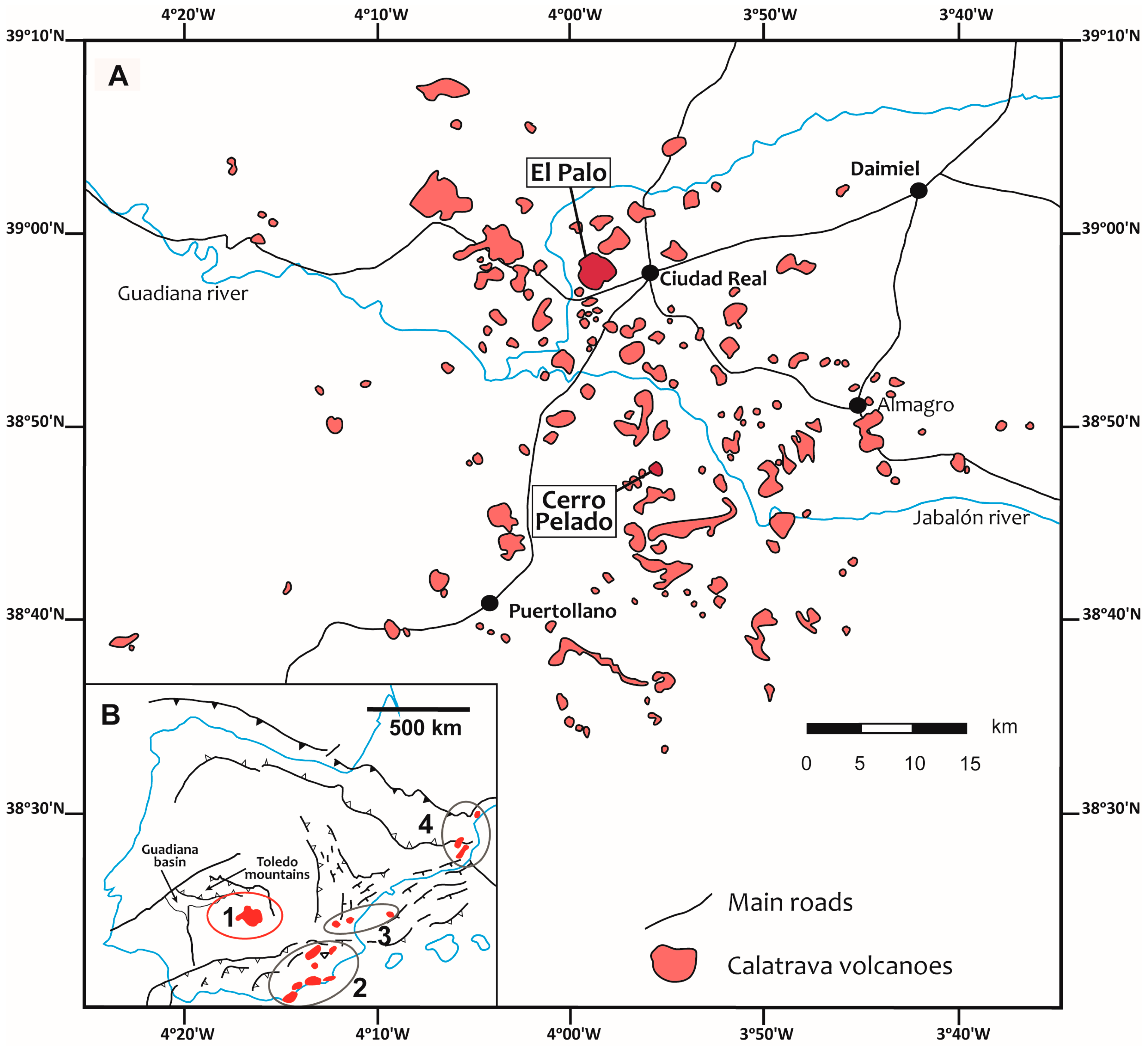
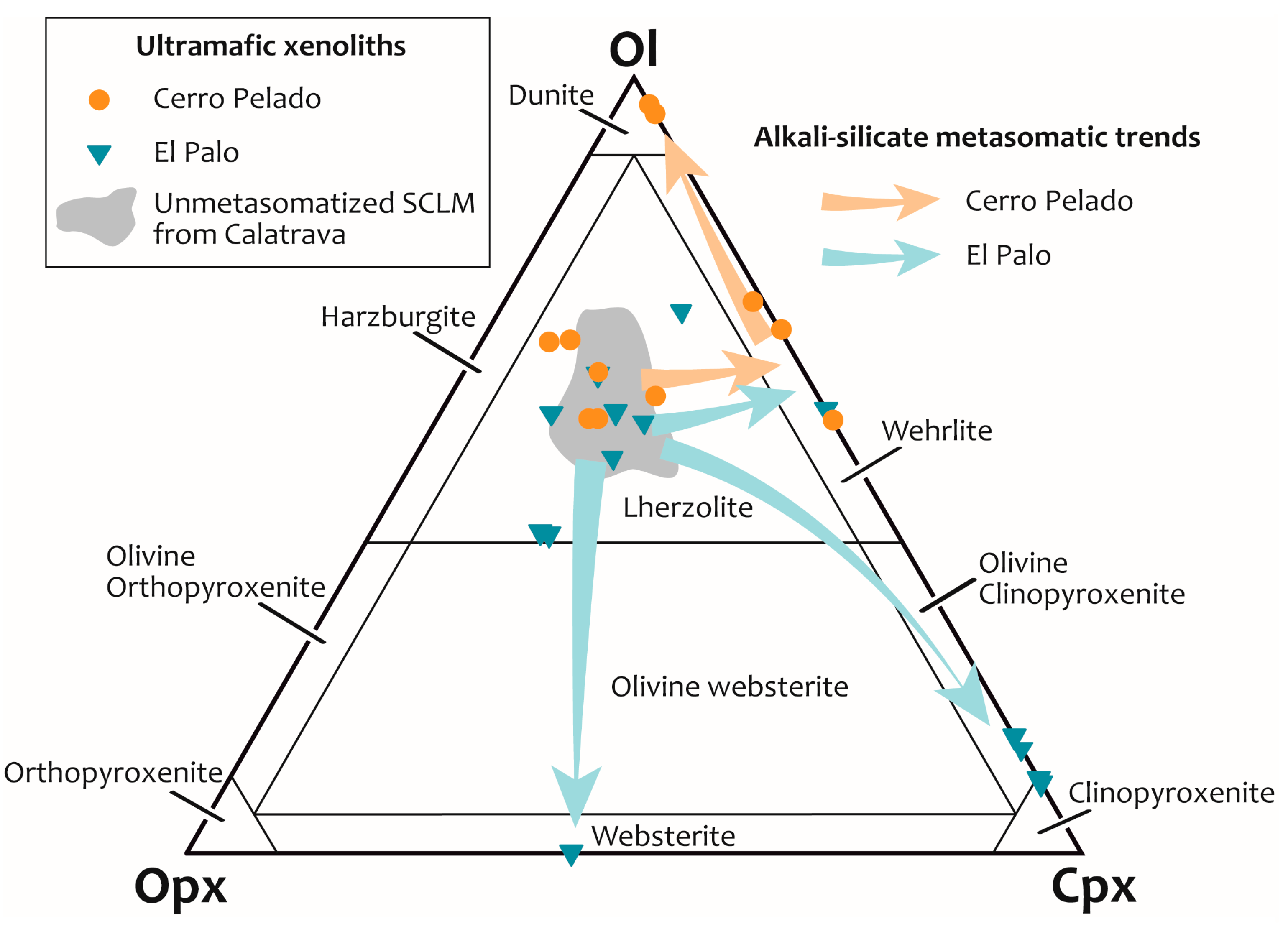
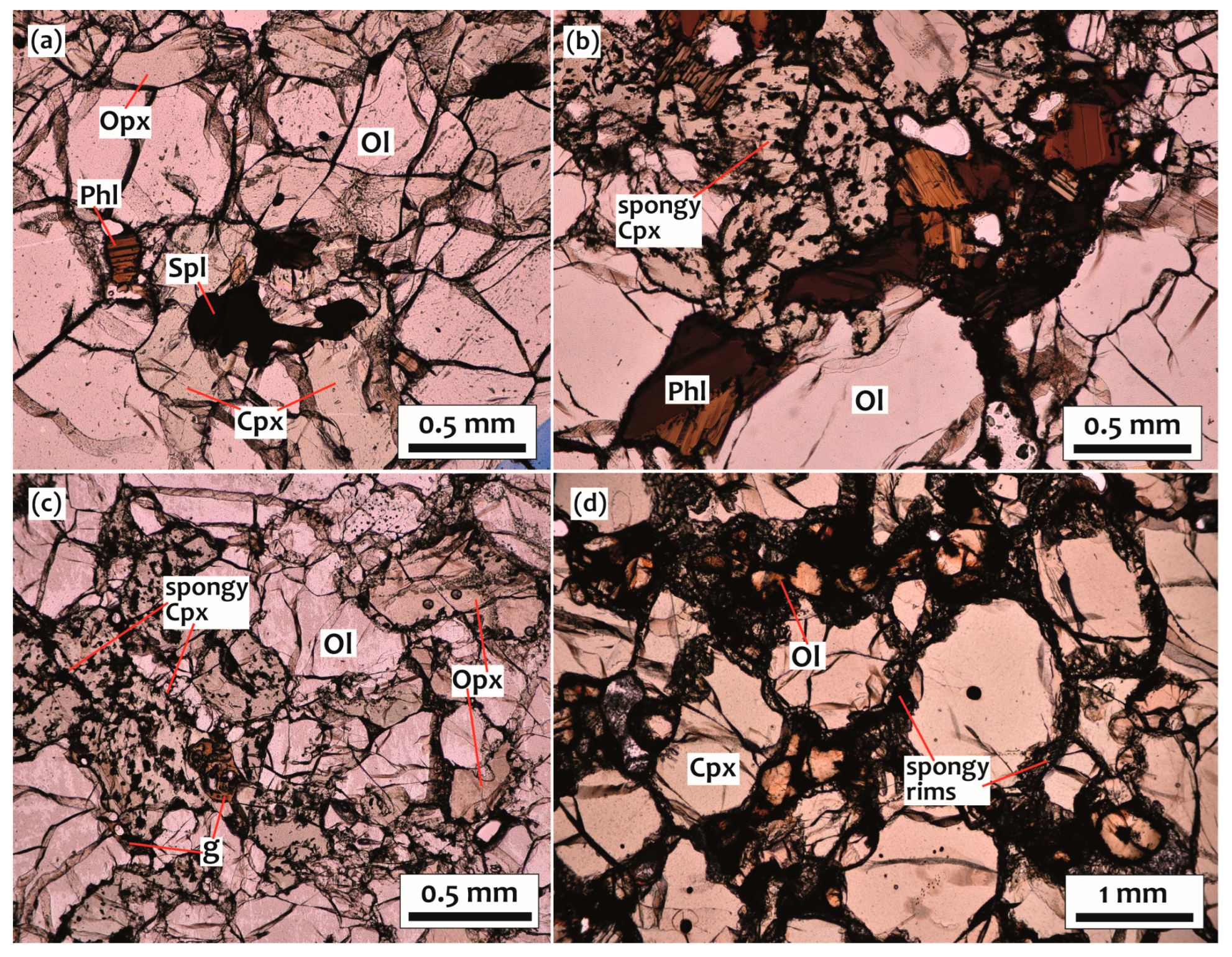
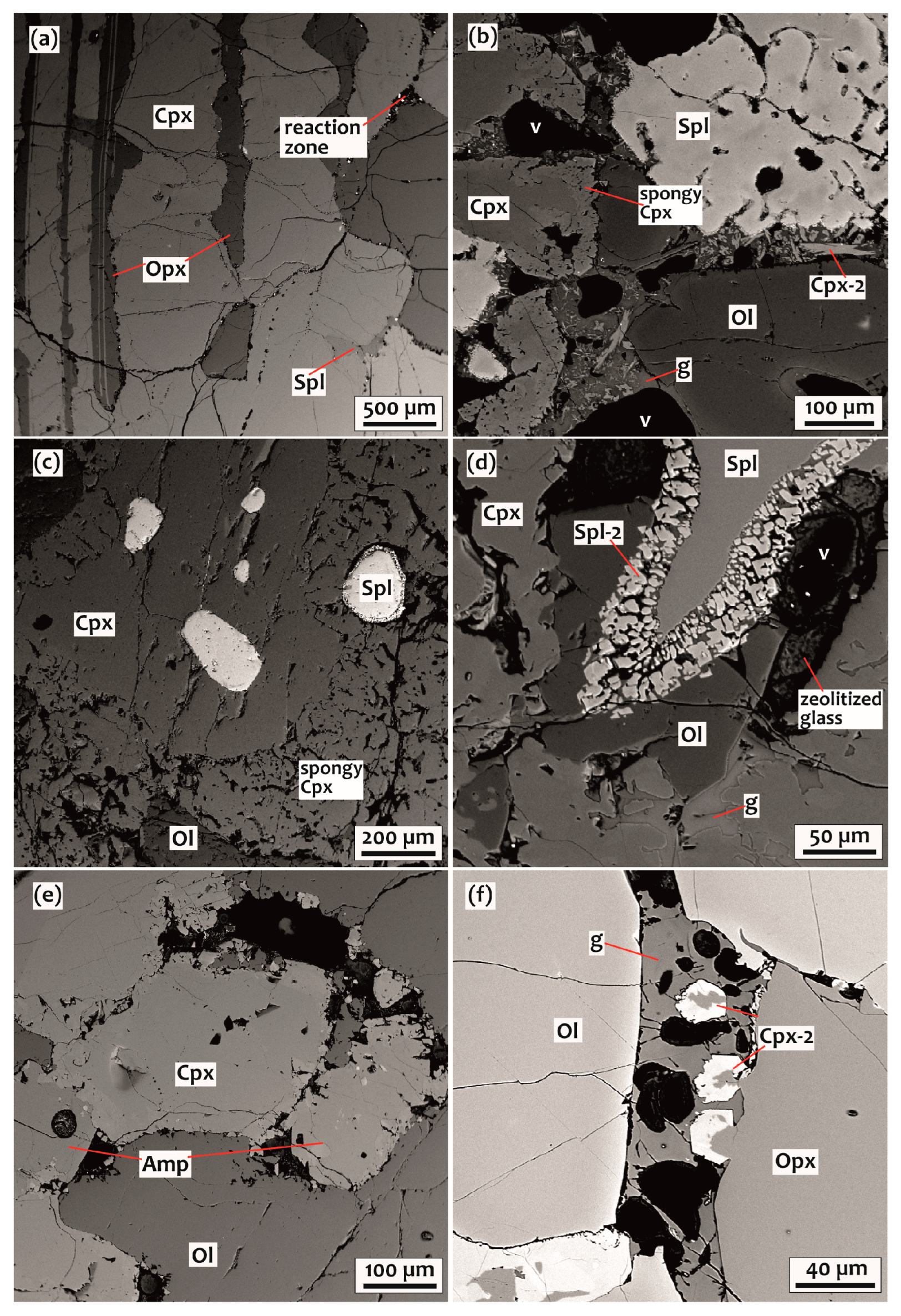
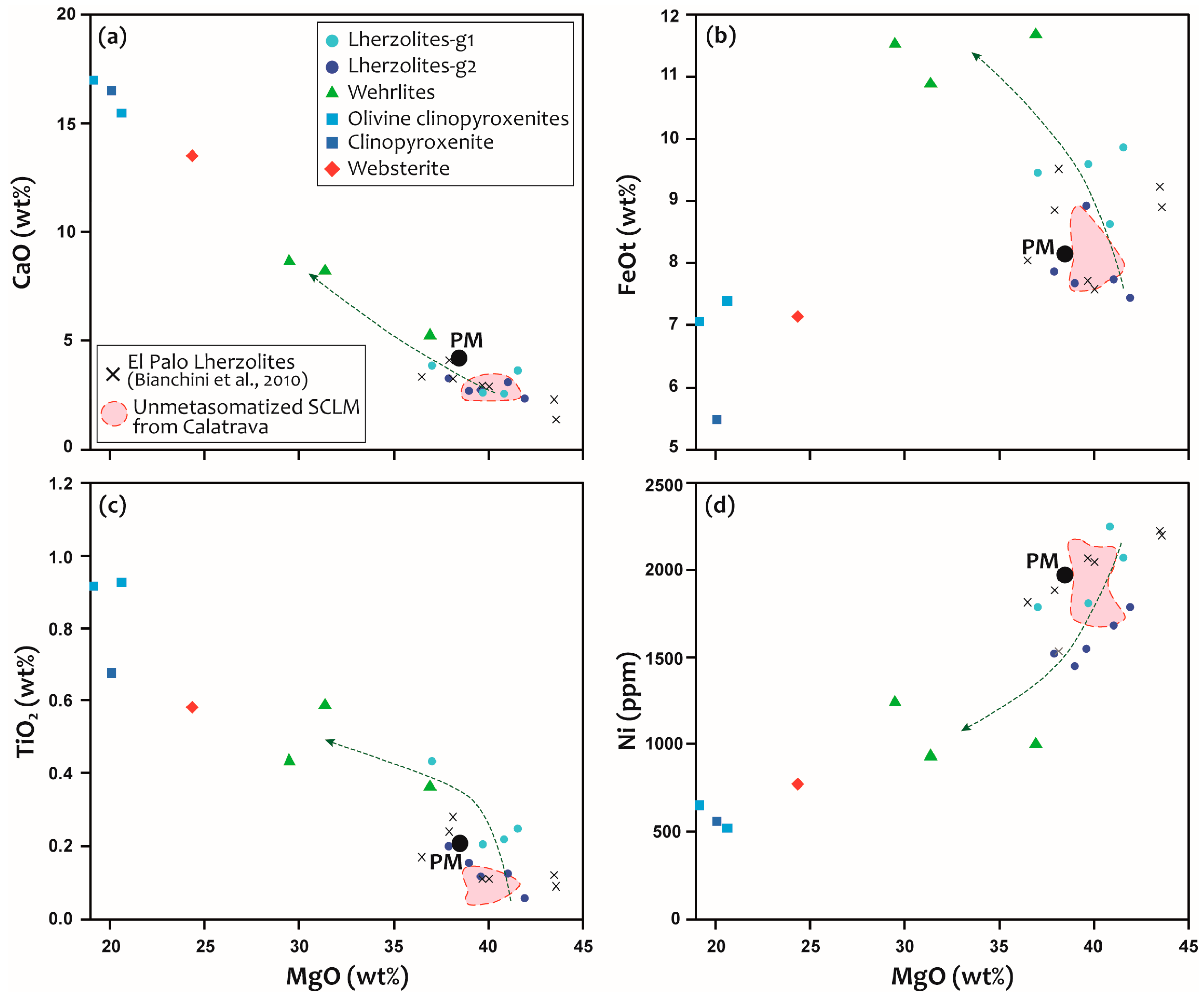
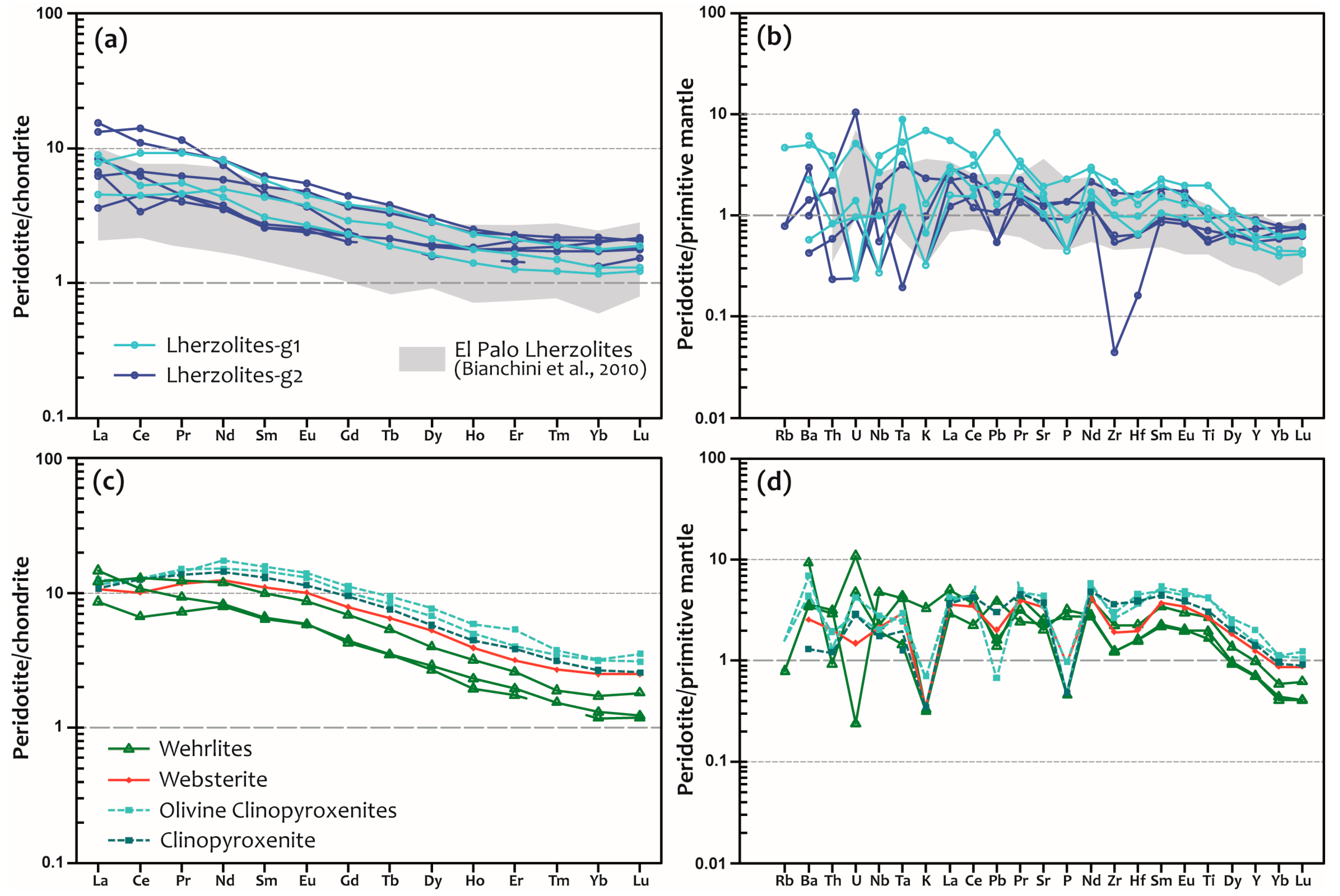


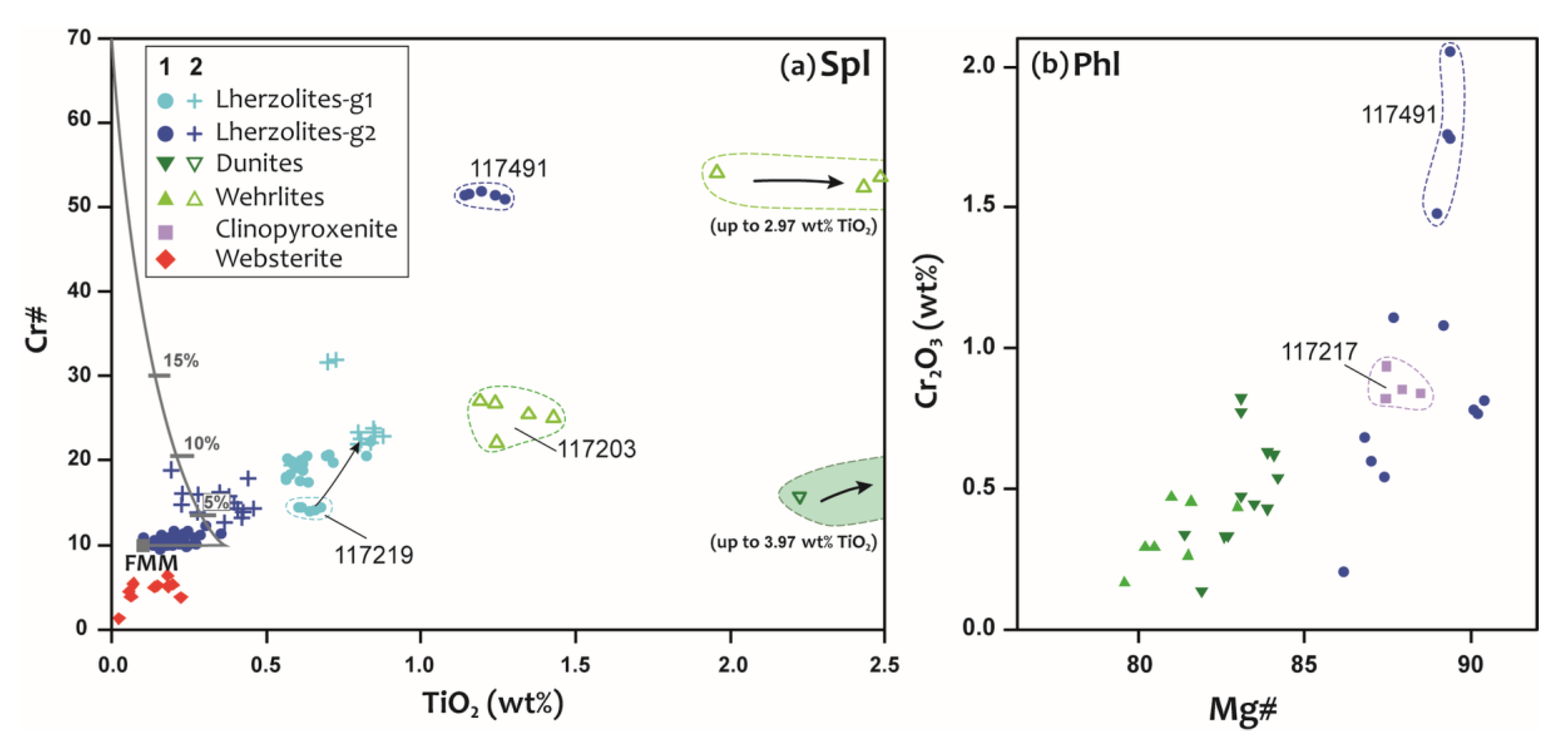
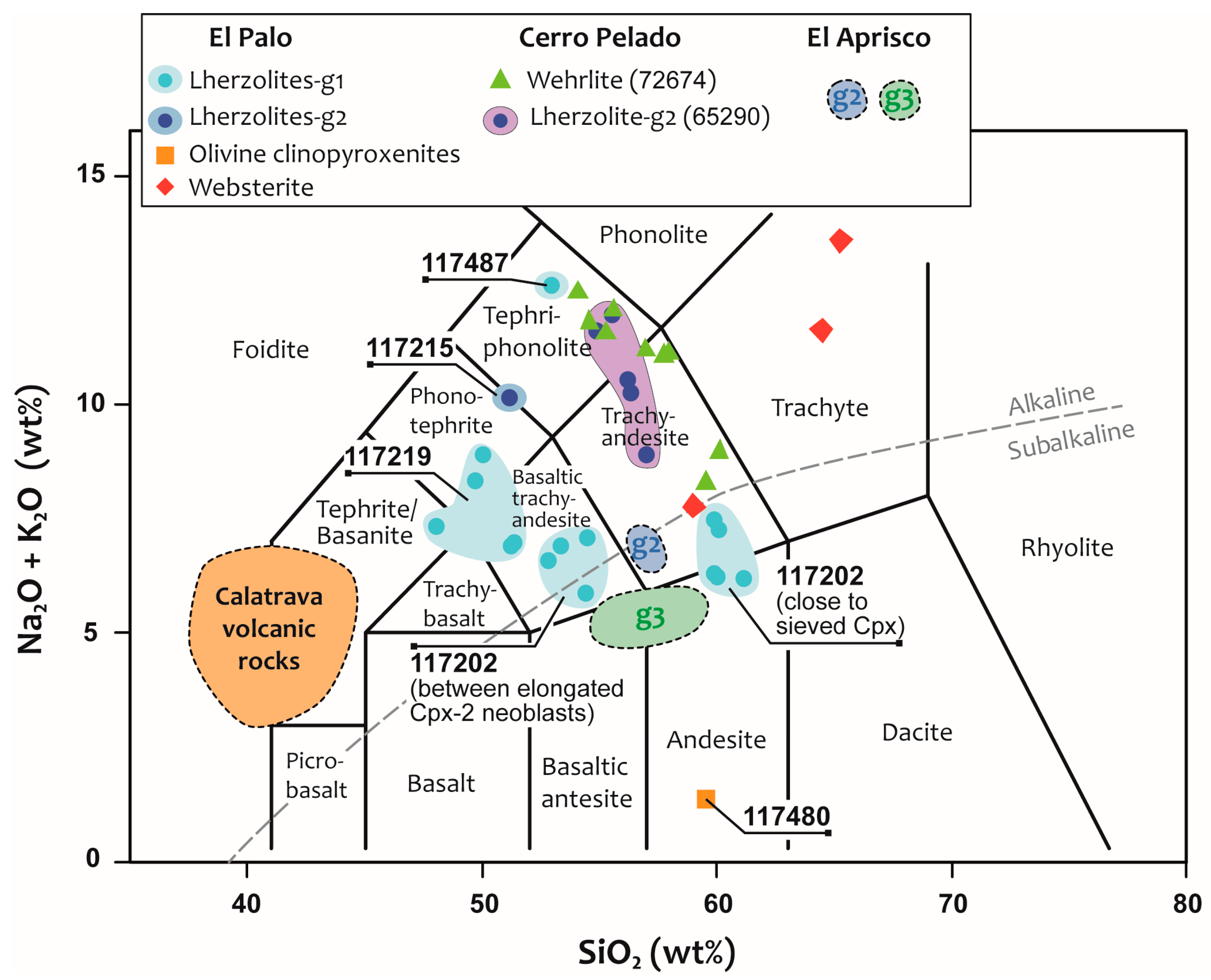


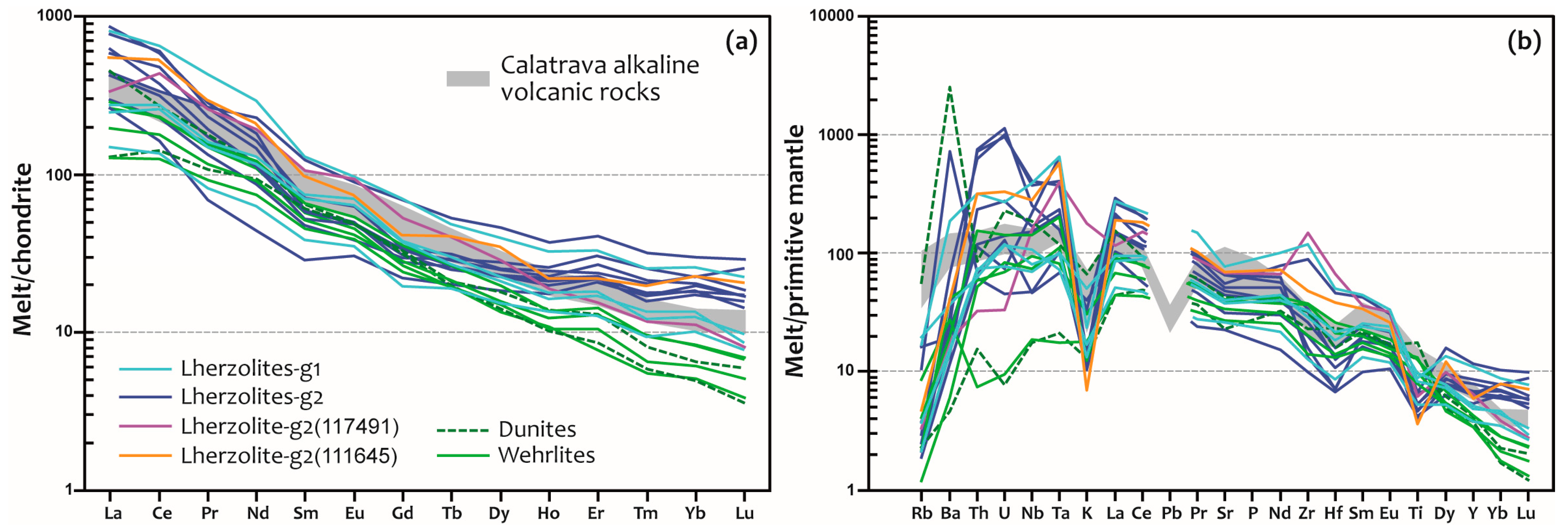
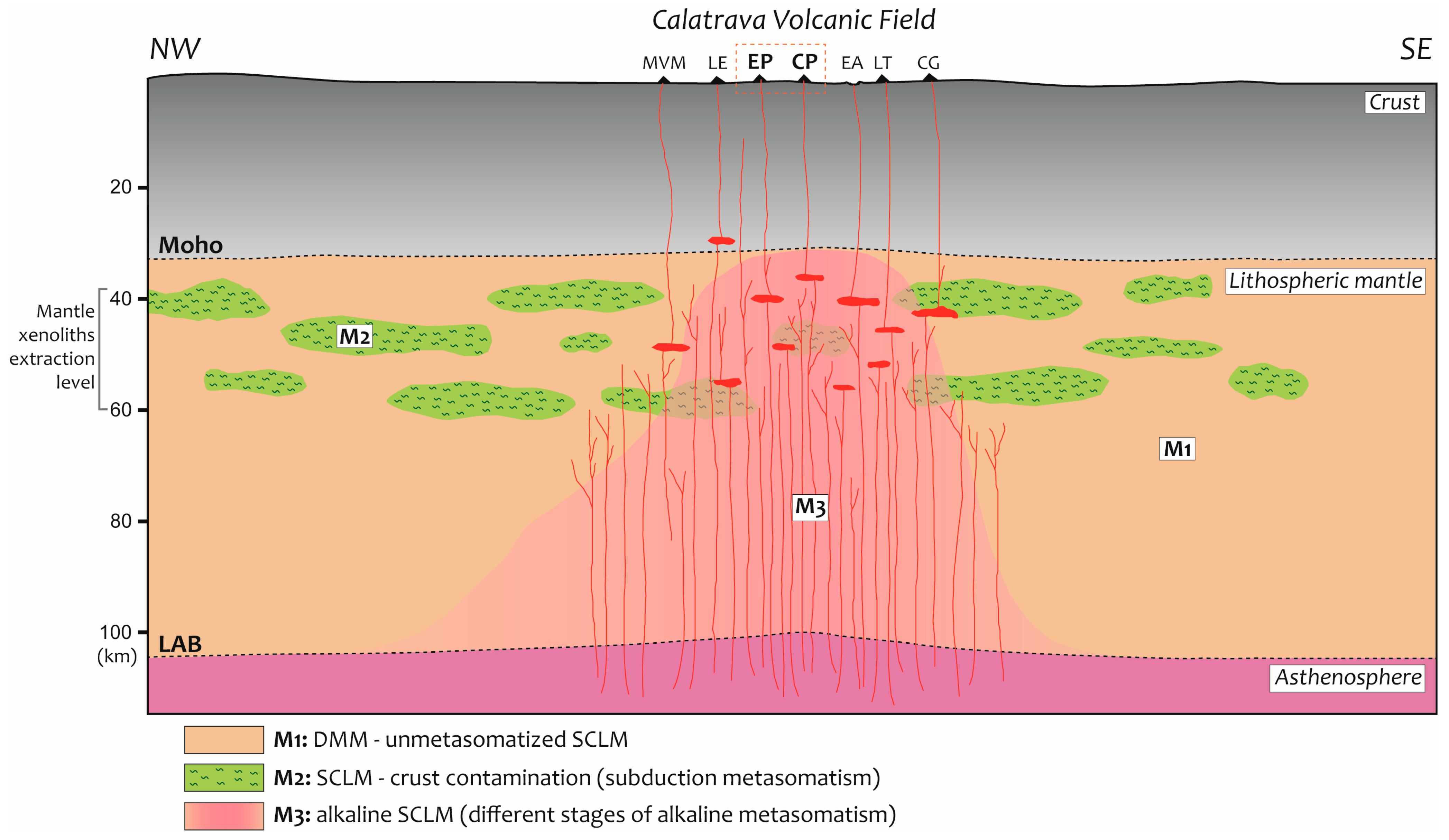
| Sample | Volcano | Texture | Calculated Modal Abundances (vol%) | ||||||
|---|---|---|---|---|---|---|---|---|---|
| Ol | Opx | Cpx | Spl | Phl | Amp | Glass | |||
| Lherzolites-g1 | |||||||||
| 117202 | El Palo | Prg | 52.6 | 22.0 | 18.2 | 4.5 | - | - | 2.6 |
| 117207 | El Palo | Prg | 52.5 | 20.1 | 22.2 | 3.0 | - | - | 2.2 |
| 117219 | El Palo | Prg | 66.9 | 9.5 | 19.7 | 2.5 | - | 1.5 | |
| 117487 | El Palo | Pfc | 39.5 | 38.3 | 18.1 | 4.0 | - | - | 0.1 |
| Lherzolites-g2 | |||||||||
| 65290 | Cerro Pelado | Prg | 54.4 | 25.5 | 17.7 | 1.9 | - | - | 0.5 |
| 65294 | Cerro Pelado | Eq | 57.5 | 17.9 | 22.5 | 2.0 | - | - | 0.1 |
| 65298 | Cerro Pelado | Prg | 60.7 | 22.8 | 14.9 | 1.5 | 0.1 | - | - |
| 111642 | Cerro Pelado | Prg | 52.6 | 25.8 | 16.1 | 5.2 | - | - | 0.2 |
| 111645 | Cerro Pelado | Prg | 55.8 | 16.7 | 19.9 | 4.1 | 1.4 | 0.9 | 1.2 |
| 111652 | Cerro Pelado | Prg | 63.3 | 23.4 | 9.7 | 3.0 | - | - | 0.6 |
| 117215 | El Palo | Prg | 54.8 | 30.1 | 12.1 | 2.9 | - | - | <0.1 |
| 117483 | El Palo | Prg | 48.9 | 25.9 | 21.3 | 3.9 | - | - | <0.1 |
| 117484 | El Palo | Pfc | 59.7 | 22.6 | 14.9 | 2.8 | - | - | <0.1 |
| 117486 | El Palo | Prg | 39.2 | 37.3 | 19.3 | 4.2 | - | - | <0.1 |
| 117491 | Cerro Pelado | Eq | 63.1 | 25.6 | 7.5 | 2.6 | 0.9 | - | 0.2 |
| Metasomatic dunites | |||||||||
| 111640 | Cerro Pelado | Prg | 87.2 | - | 3.8 * | - | 7.9 | - | 1.1 |
| 111648 | Cerro Pelado | Prg | 91.2 | - | 4.5 * | 0.4 | 2.4 | - | 1.5 |
| Wehrlites | |||||||||
| 72674 | Cerro Pelado | Prg | 69.7 | 1.4 | 27.5 * | 0.1 | 0.1 | - | 1.2 |
| 110856 | Cerro Pelado | Prg | 61.6 | - | 30.2 * | - | 6.1 | - | 2.1 |
| 116604 | Cerro Pelado | Eq | 53.3 | - | 43.0 * | 1.8 | - | - | 1.8 |
| 117203 | El Palo | Eq | 55.6 | - | 41.9 | 1.6 | - | - | 0.9 |
| Websterite | |||||||||
| 117205 | El Palo | Prg | - | 55.8 | 42.1 | 1.4 | - | - | 0.6 |
| Olivine Clinopyroxenites | |||||||||
| 117480 | El Palo | Eq | 13.1 | - | 85.4 | - | - | - | 1.6 |
| 117482 | El Palo | Prg | 14.8 | - | 84.7 | - | - | - | 0.5 |
| Clinopyroxenites | |||||||||
| 117217 | El Palo | Prg | 9.3 | - | 88.8 | - | <0.1 | - | 1.9 |
| 117485 | El Palo | Prg | 8.7 | - | 88.5 | - | - | - | 2.8 |
Disclaimer/Publisher’s Note: The statements, opinions and data contained in all publications are solely those of the individual author(s) and contributor(s) and not of MDPI and/or the editor(s). MDPI and/or the editor(s) disclaim responsibility for any injury to people or property resulting from any ideas, methods, instructions or products referred to in the content. |
© 2024 by the authors. Licensee MDPI, Basel, Switzerland. This article is an open access article distributed under the terms and conditions of the Creative Commons Attribution (CC BY) license (https://creativecommons.org/licenses/by/4.0/).
Share and Cite
García Serrano, J.; Villaseca, C.; Pérez-Soba, C.; Román-Alpiste, M.J. Alkaline Silicate Metasomatism Recorded through Fe-Ti-Rich Mantle Xenoliths from the Calatrava Volcanic Field (Spain). Minerals 2024, 14, 241. https://doi.org/10.3390/min14030241
García Serrano J, Villaseca C, Pérez-Soba C, Román-Alpiste MJ. Alkaline Silicate Metasomatism Recorded through Fe-Ti-Rich Mantle Xenoliths from the Calatrava Volcanic Field (Spain). Minerals. 2024; 14(3):241. https://doi.org/10.3390/min14030241
Chicago/Turabian StyleGarcía Serrano, Javier, Carlos Villaseca, Cecilia Pérez-Soba, and Manuel Jesús Román-Alpiste. 2024. "Alkaline Silicate Metasomatism Recorded through Fe-Ti-Rich Mantle Xenoliths from the Calatrava Volcanic Field (Spain)" Minerals 14, no. 3: 241. https://doi.org/10.3390/min14030241
APA StyleGarcía Serrano, J., Villaseca, C., Pérez-Soba, C., & Román-Alpiste, M. J. (2024). Alkaline Silicate Metasomatism Recorded through Fe-Ti-Rich Mantle Xenoliths from the Calatrava Volcanic Field (Spain). Minerals, 14(3), 241. https://doi.org/10.3390/min14030241






